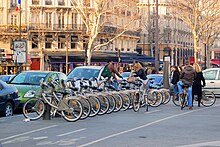Cycling in Paris
Paris has steadily increased its network of bicycle paths since the late 1990s. As of 2015 there is 700 km (430 mi) of cycling routes in Paris,[1] including bike paths and bus lanes that had been widened for use by bike riders.
Development of cycling in Paris[]
Nearly disappeared in the 1980s (car traffic was at the time 85 times more important than cycling[2]), cycling has grown since the 1990s.
Cycle ways and routes within Paris[]
There are 700 km (430 mi) of cycle paths and routes in Paris. These include piste cyclable (bike lanes separated from other traffic by physical barriers such as a kerb) and bande cyclable (a bicycle lane denoted by a painted path on the road). Also since 2008, 29 km (18 mi) of specially marked bus lanes are free to be used by cyclists.[3] Cyclists have also been given the right to ride in both directions on certain one-way streets (20 mph zone).
Paris' bike routes are detailed in guides such as Paris de Poche: Cycliste et Piéton (i.e. Pocket Paris: Cyclist and Pedestrian) which costs about €5 or the free Paris à Velo available from Paris town hall offices.
Vélib'[]
Following the successful examples of bicycle hire schemes in the French cities of Rennes and Lyon the city of Paris launched a system of rental bikes free service called Vélib' on 15 July 2007. Managed by the company JCDecaux there were originally 10,648 bikes available at 750 Vélib' stations. More than 20,600 bikes at 1,451 stations are planned for late 2007 and Paris may eventually have 50,000 Vélib' bikes for hire.
Vélib's main aim is to replace car use in Paris for short trips.
Paris Respire[]
Paris Respire (literally "Paris Breathes") is a car-free scheme where certain roads are closed to vehicular traffic on Sundays and public holidays between the hours of 9am and 5pm. The roads closed include those by the River Seine, in the Marais, the Canal Saint Martin, Montmartre as well as roads elsewhere in the city.[4] Cycling and walking are the main forms of getting around on these roads on these days.
National and international cycle routes[]
Voies vertes[]
Some of the French cycle routes known as Voies vertes (literally "green ways") pass through Paris. One is the Piste du canal de L'Ourcq (the Ourcq canal path) which runs 97 km (60 mi) through Paris to Sevran.[5]
EuroVelo and other international routes[]
The long-distance cycle path EuroVelo 3, dubbed the Pilgrim's Route, running between Santiago de Compostela in Spain and Trondheim in Norway passes through Paris.
Other international routes include the Avenue Verte route which runs between Paris and London. The Avenue Verte crosses the English Channel at Dieppe via the Newhaven – Dieppe ferry.
Sports practice[]

Paris has within its border two tracks where cyclists can practice their activities. The first place is an oval track of 3.6km located around the Longchamp Racecourse in the 16th district and is used by cyclists since the end of the 19th century when appeared the first cycling competitions. Today, the track is the most used segment in France on the sport social media Strava and one of most popular in the world. The second place is called "" and is located at the Bois de Vincennes in the 12th district of Paris. The track was recently refurbished.
Future developments[]
As announced in April 2015, Plan velo up to year 2020 Paris will increase the size of its bike path network or pistes cyclables to 1,400 km (870 mi) plus many smaller streets with both way cycling and secure parking at several train stations, total budget is 150m euro
See also[]
References[]
- ^ Pineau, Elizabeth (12 August 2010). "Paris: from tyranny of taxis to city of bikes". Toronto: The Globe and Mail. Retrieved 25 March 2011.
- ^ Demade 2015, p. 85.
- ^ Pourquoi ouvrir les couloirs de bus aux vélos?
- ^ Sundays in Paris: ‘Paris Respire’
- ^ Les Véloroutes et voies vertes de Paris Archived 22 December 2010 at the Wayback Machine
Bibliography[]
- Demade, Julien (2015). Les embarras de Paris, ou l'illusion techniciste de la politique parisienne des déplacements. L'Harmattan. ISBN 978-2-343-06517-5.
External links[]
| Wikimedia Commons has media related to Cycling in Paris. |
- Cycling in Paris
- Cycling by city
- Transport in Paris


